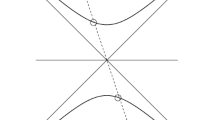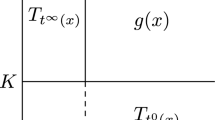Abstract
Since electrons in a ballistic regime perceive a carbon nanotube or a graphene layer structure as a continuous medium, we can use the study of the quantum dynamics of one electron constrained to a curve or surface to obtain a qualitative description of the conduction electrons’ behavior. The confinement process of a quantum particle to a curve or surface leads us, in the so-called confining potential formalism, to a geometry-induced potential in the effective Schrödinger equation. With these considerations, this work aims to study in detail the consequences of constraining a quantum particle to a helix, catenary, helicoid, or catenoid, exploring the relations between these curves and surfaces using differential geometry. Initially, we use the variational method to estimate the energy of the particle in its ground state, and thus, we obtain better approximations with the use of the confluent Heun function through numerical calculations. Thus, we conclude that a quantum particle constrained to an infinite helix has its angular momentum quantized due to the geometry of the curve, while in the cases of the catenary, helicoid, and catenoid the particle can be found either in a single bound state or in excited states which constitute a continuous energy band. Additionally, we propose measurements of physical observables capable of discriminating the topologies of the studied surfaces, in the context of topological metrology.

















Similar content being viewed by others
References
H. Terrones, M. Terrones, Curved nanostructured materials. New J. Phys. 5, 126 (2003)
H. Jensen, H. Koppe, Quantum mechanics with constraints. Ann. Phys. 63, 586 (1971)
R.C.T. da Costa, Quantum mechanics of a constrained particle. Phys. Rev. A 23, 1982 (1981)
R.C.T. da Costa, Constraints in quantum mechanics. Phys. Rev. A 25, 2893 (1982)
P.C. Schuster, R. Jaffe, Quantum mechanics on manifolds embedded in Euclidean space. Ann. Phys. 307, 132 (2003)
A. Szameit, F. Dreisow, M. Heinrich, R. Keil, S. Nolte, A. Tünnermann, S. Longhi, Geometric potential and transport in photonic topological crystals. Phys. Rev. Lett. 104, 150403 (2010)
J. Onoe, T. Ito, H. Shima, H. Yoshioka, S.I. Kimura, Observation of Riemannian geometric effects on electronic states. Europhys. Lett. 98, 27001 (2012)
T. Zhang, X. Li, H. Gao, Defects controlled wrinkling and topological design in graphene. J. Mech. Phys. Solids 67, 2 (2014)
F. Santos, S. Fumeron, B. Berche, F. Moraes, Geometric effects in the electronic transport of deformed nanotubes. Nanotechnology 27, 135302 (2016)
Y.N. Joglekar, A. Saxena, Curvature-induced p-n junctions in bent or folded bilayer graphene sheets. Phys. Rev. B 80, 153405 (2009)
J.E.G. Silva, J. Furtado, T.M. Santiago, A.C.A. Ramos, D.R. da Costa, Electronic properties of bilayer graphene catenoid bridge. Phys. Lett. A 384, 126458 (2020)
V. Atanasov, R. Dandoloff, A. Saxena, Geometry-induced charge separation on a Helicoidal Ribbon. Phys. Rev. B 79, 033404 (2009)
R. Dandoloff, T.T. Truong, Quantum Hall-like effect on strips due to geometry. Phys. Lett. A 325, 233 (2004)
F. dos S Azevedo, J.D.M. de Lima, A. de Pádua Santos, F. Moraes, Optical wormhole from hollow disclinations. Phys. Rev. A 103, 023516 (2021)
S. Gupta, A. Saxena, Negative Gaussian curvature distribution in physical and biophysical systems-curved nanocarbons and ion-channel membrane proteins. J. Appl. Phys. 112, 114316 (2012)
S. Gupta, A. Saxena, Geometrical interpretation and curvature distribution in nanocarbons. J. Appl. Phys. 109, 074316 (2011)
S. Gupta, A. Saxena (eds.), The Role of Topology in Materials, Springer Series in Solid-State Sciences, vol. 189 (Springer, Cham, 2018)
M. Gingras, One hundred years of helicene chemistry. Part 1: non-stereoselective syntheses of carbohelicenes. Chem. Soc. Rev. 42, 968 (2013)
J.J. Stoker, Differential Geometry (Wiley Classics Library, New York, 1989)
D.J. Struik, Lectures on Classical Differential Geometry (Dover, New York, 1988)
M.P. do Carmo, Differential Geometry of Curves and Surfaces: Revised and Updated, 2nd edn. (Courier Dover Publications, New York, 2016)
R. Dandoloff, A. Saxena, B. Jensen, Geometry-induced potential on a two-dimensional section of a wormhole: Catenoid. Phys. Rev. A 81, 014102 (2010)
M.C.R. Ribeiro Jr., M.M. Cunha, C. Filgueiras, E.O. Silva, Quantum particle motion on the surface of a helicoid in the presence of an harmonic oscillator. Phys. Open 5, 100045 (2020)
C.C. Bastos, A.C. Pavão, E.S. Leandro, On the quantum mechanics of a particle constrained to generalized cylinders with application to Möbius strips. J. Math. Chem. 54, 1822 (2016)
L.C.B. da Silva, C.C. Bastos, F.G. Ribeiro, Quantum mechanics of a constrained particle and the problem of prescribed geometry-induced potential. Ann. Phys. 379, 13 (2017)
B.J. Bernard, L.C.L.Y. Voon, Notes on the quantum mechanics of particles constrained to curved surfaces. Eur. J. Phys. 34, 1235 (2013)
S. Kar, D. Sahdev, B. Bhawal, Scalar waves in a wormhole geometry. Phys. Rev. D 49, 853 (1994)
M.A. Cirone, K. Rzazewski, W.P. Schleich, F. Straub, J. Wheeler, Quantum anticentrifugal force. Phys. Rev. A 65, 022101 (2001)
V. Atanasov, R. Dandoloff, Curvature induced quantum potential on deformed surfaces. Phys. Lett. A 371, 118 (2007)
N. Zettili, Quantum Mechanics: Concepts and Applications (Wiley, West Sussex, 2009)
J.J. Sakurai, J. Napolitano, Modern Quantum Mechanics, 2nd edn. (Cambridge University Press, Cambridge, 2017)
I.S. Gradshteyn, I.M. Ryzhik, Table of Integrals, Series, and Products (Elsevier, Burlington, 2007)
F.W.J. Olver, D.W. Lozier, R.F. Boisvert, C.W. Clark, NIST Handbook of Mathematical Functions (Cambridge University Press, Cambridge, 2010)
R.R. Hartmann, Bound states in a hyperbolic asymmetric double-well. J. Math. Phys. 55, 012105 (2014)
R.R. Hartmann, M.E. Portnoi, Two-dimensional Dirac particles in a Pöschl-Teller waveguide. Sci. Rep. 7, 1 (2017)
A.M. Ishkhanyan, Schrödinger potentials solvable in terms of the confluent Heun functions. Theor. Math. Phys. 188, 980 (2016)
H. Karayer, D. Demirhan, F. Büyükkılıç, Extension of Nikiforov-Uvarov method for the solution of Heun equation. J. Math. Phys. 56, 063504 (2015)
A. Ronveaux (ed.), Heun’s Differential Equations (Oxford University Press, Oxford, 1995)
G. Kristensson, Second Order Differential Equations: Special Functions and Their Classification (Springer, New York, 2010)
A. Ishkhanyan, Schrödinger potentials solvable in terms of the general Heun functions. Ann. Phys. 388, 456 (2018)
C.A. Downing, On a solution of the Schrödinger equation with a hyperbolic double-well potential. J. Math. Phys. 54, 072101 (2013)
R. Boyack, J. Lekner, Confluent Heun functions and separation of variables in spheroidal coordinates. J. Math. Phys. 52, 073517 (2011)
P.P. Fiziev, Novel relations and new properties of confluent Heun’s functions and their derivatives of arbitrary order. J. Phys. A: Math. Theor. 43, 035203 (2009)
S. Dong, Q. Fang, B.J. Falaye, G.H. Sun, C. Yáñez Márquez, S.H. Dong, Exact solutions to solitonic profile mass Schrödinger problem with a modified Pöschl-Teller potential. Modern Phys. Lett. A 31, 1650017 (2016)
S. Dong, G.H. Sun, B.J. Falaye, S.H. Dong, Semi-exact solutions to position-dependent mass Schrödinger problem with a class of hyperbolic potential V\({}_{0}\)tanh(ax). Eur. Phys. J. Plus 131, 1 (2016b)
Q. Dong, F. A. Serrano, G. H. Sun, J. Jing, S. H. Dong, Semiexact solutions of the Razavy potential. Adv. High Energy Phys. 2018 (2018)
Q. Dong, A.J.T. Arenas, G.H. Sun, O. Camacho Nieto, S. Femmam, S.H. Dong, Exact solutions of the sine hyperbolic type potential. J. Math. Chem. 57, 1924 (2019)
F.M. Fernández, Wronskian method for bound states. Eur. J. Phys. 32, 723 (2011)
A.E. Sitnitsky, Exactly solvable Schrödinger equation with double-well potential for hydrogen bond. Chem. Phys. Lett. 676, 169 (2017)
MAPLE, Maplesoft, A Division of Waterloo Maple Inc. (MAPLE, Waterloo, 2017)
Y. Aharonov, D. Bohm, Significance of electromagnetic potentials in the quantum theory. Phys. Rev. 115, 485 (1959)
S. Gupta, A. Saxena, A topological twist on materials science. MRS Bull. 39, 265 (2014)
I.M. Lifshitz et al., Anomalies of electron characteristics of a metal in the high pressure region. Sov. Phys. JETP 11, 1130 (1960)
M. Vergniory, L. Elcoro, C. Felser, N. Regnault, B.A. Bernevig, Z. Wang, A complete catalogue of high-quality topological materials. Nature 566, 480 (2019)
L. Ford, A. Vilenkin, A gravitational analogue of the Aharonov-Bohm effect. J. Phys. A: Math. Gen. 14, 2353 (1981)
AMdM Carvalho, C. Sátiro, F. Morae, Aharonov-Bohm-like effect for light propagating in nematics with disclinations. Europhys. Lett. 80, 46002 (2007)
A.M.D.M. Carvalho, C.A. de Lima Ribeiro, F. Moraes, C. Furtado, Holonomy transformations and application in the curved structure of graphene. Eur. Phys. J. Plus 128, 1 (2013)
E. Pereira, F. Moraes, Diffraction of light by topological defects in liquid crystals. Liq. Cryst. 38, 295 (2011)
T. Stegmann, N. Szpak, Current splitting and valley polarization in elastically deformed graphene. 2D Mater 6, 015024 (2018)
Y.L. Wang, H.S. Zong, H. Liu, Y.F. Chen, Geometry-induced quantum Hall effect and Hall viscosity. Phys. Rev. B 102, 155153 (2020)
Acknowledgements
This study was financed in part by the Coordenação de Aperfeiçoamento de Pessoal de Nível Superior–Brasil (CAPES)—Finance Code 001 (F.F.S.F.), Fundação de Amparo à Ciência e Tecnologia do Estado de Pernambuco (FACEPE), Grants No. IBPG-0487-1.05/19 (J.D.M.L.), and BIC-1187-1.05/20 (E.G.), and Conselho Nacional de Desenvolvimento Científico e Tecnológico (CNPq), Grant No. 307687/2017-1 (F.M.). The authors are indebted to L.C.B. da Silva for invaluable discussions and suggestions.
Author information
Authors and Affiliations
Corresponding author
Rights and permissions
About this article
Cite this article
de Lima, J.D.M., Gomes, E., da Silva Filho, F.F. et al. Geometric effects on the electronic structure of curved nanotubes and curved graphene: the case of the helix, catenary, helicoid, and catenoid. Eur. Phys. J. Plus 136, 551 (2021). https://doi.org/10.1140/epjp/s13360-021-01533-6
Received:
Accepted:
Published:
DOI: https://doi.org/10.1140/epjp/s13360-021-01533-6




